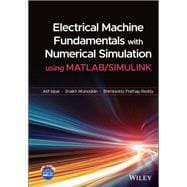A comprehensive text, combining all important concepts and topics of Electrical Machines and featuring exhaustive simulation models based on MATLAB/Simulink
Electrical Machine Fundamentals with Numerical Simulation using MATLAB/Simulink provides readers with a basic understanding of all key concepts related to electrical machines (including working principles, equivalent circuit, and analysis). It elaborates the fundamentals and offers numerical problems for students to work through. Uniquely, this text includes simulation models of every type of machine described in the book, enabling students to design and analyse machines on their own.
Unlike other books on the subject, this book meets all the needs of students in electrical machine courses. It balances analytical treatment, physical explanation, and hands-on examples and models with a range of difficulty levels. The authors present complex ideas in simple, easy-to-understand language, allowing students in all engineering disciplines to build a solid foundation in the principles of electrical machines. This book:
- Includes clear elaboration of fundamental concepts in the area of electrical machines, using simple language for optimal and enhanced learning
- Provides wide coverage of topics, aligning with the electrical machines syllabi of most international universities
- Contains extensive numerical problems and offers MATLAB/Simulink simulation models for the covered machine types
- Describes MATLAB/Simulink modelling procedure and introduces the modelling environment to novices
- Covers magnetic circuits, transformers, rotating machines, DC machines, electric vehicle motors, multiphase machine concept, winding design and details, finite element analysis, and more
Electrical Machine Fundamentals with Numerical Simulation using MATLAB/Simulink is a well-balanced textbook perfect for undergraduate students in all engineering majors. Additionally, its comprehensive treatment of electrical machines makes it suitable as a reference for researchers in the field.








